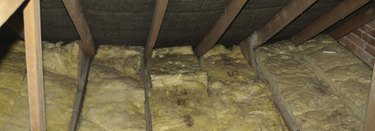
The normal movement of air in a house is from the cooler lower floors to the warmer upper ones -- and finally out through cracks in upper windows and walls. Depending on how well the house is sealed, this movement often leads to an accumulation of warm air in the attic, and that can contribute to mold growth. You can clean mold and mildew off attic surfaces, but to prevent it in the first place, you may have to improve the ventilation.
Importance of Attic Mold Remediation
Video of the Day
If you find mold in your attic, some good news may brighten your day: Normal air circulation will keep it in place unless you have a pressurized ventilation system that forces attic air into the rest of the house. This doesn't make attic mold remediation optional, however. Moldy insulation is usually wet and compressed, which means it isn't doing its job. Attic mold can deteriorate joists, rafter and roof decking if left unchecked, and it can grow on items that you store in the attic, such as books, furniture and clothing. If you leave these items in a moldy attic long enough, you'll probably end up having to throw them out.
Video of the Day
Mold Grows in Moisture
In a properly vented attic, air circulates from lower vents -- usually located in the roof soffits -- to higher ones in the roof decking, roof ridge or gables. When this ventilation is insufficient, warm, moist air stagnates, creating the ideal conditions for mold growth on surfaces that provide it with nutrients, such as wood, insulation and drywall. Water leaks are another common cause of attic mold; a slow leak through the roof, for example, can feed mold colonies on the underside of the roof decking, on the rafters and in the part of the ceiling insulation where the water eventually drips. It's important to correct these moisture problems before cleaning the mold, or your efforts will be futile.
Upgrade the Attic Ventilation
Correcting insufficient attic ventilation is your single most important mold remediation procedure. In a well-sealed house, Uniform Building Code guidelines recommend 1 square foot of ventilation area for every 150 square feet of attic space; for older, more porous buildings, the ratio is 1 to 300. The ventilation square footage should be shared equally by soffit and roof vents. If your house has a flat roof, or there is another reason you can't install a passive ventilation system, provide active ventilation using fans and turbines.
Clean the Existing Mold
The most effective way to remove mold from hard, porous materials, such as wood rafters and plywood roof decking, is to scrub it with detergent and water while wearing a dust mask and rubber gloves. The EPA and other government agencies no longer recommend bleach for doing this; bleach is corrosive and nasty to use, and it kills only surface mold. Mold-infested drywall and insulation must be discarded -- there is no way to kill the spores inside it.